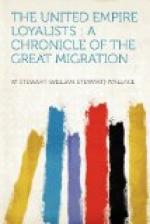The summer of 1789, however, brought relief to the settlers, and though, for many years, comforts and even necessaries were scarce, yet after 1791, the year in which the new settlements were erected into the province of Upper Canada, it may be said that most of the settlers had been placed on their feet. The soil was fruitful; communication and transportation improved; and metallic currency gradually found its way into the settlements. When Mrs Simcoe, the wife of the lieutenant-governor, passed through the country in 1792, she was struck by the neatness of the farms of the Dutch and German settlers from the Mohawk valley, and by the high quality of the wheat. ‘I observed on my way thither,’ she says in her diary, ’that the wheat appeared finer than any I have seen in England, and totally free from weeds.’ And a few months later an anonymous English traveller, passing the same way, wrote: ’In so infant a settlement, it would have been irrational to expect that abundance which bursts the granaries, and lows in the stalls of more cultivated countries. There was, however, that kind of appearance which indicated that with economy and industry, there would be enough.’
Next in size to the settlements at Cataraqui and on the Upper St Lawrence was the settlement at Niagara. During the war Niagara had been a haven of refuge for the Loyalists of Pennsylvania and the frontier districts, just as Oswego and St Johns had been havens of refuge for the Loyalists of northern and western New York. As early as 1776 there arrived at Fort George, Niagara, in a starving condition, five women and thirty-six children, bearing names which are still to be found in the Niagara peninsula. From that date until the end of the war refugees continued to come in. Many of these refugees were the families of the men and officers of the Loyalist troops stationed at Niagara. On September 27, 1783, for instance, the officer commanding at Niagara reports the arrival from Schenectady of the wives of two officers of Butler’s Rangers, with a number of children. Some of these people went down the lake to Montreal; but others remained at the post, and ‘squatted’ on the land. In 1780 Colonel Butler reports to Haldimand that four or five families have settled and built houses, and he requests that they be given seed early in the spring. In 1781 we know that a Loyalist named Robert Land had squatted on Burlington Bay, at the head of Lake Ontario. In 1783 Lieutenant Tinling was sent to Niagara to survey lots, and Sergeant Brass of the 84th was sent to build a saw-mill and a grist-mill. At the same time Butler’s Rangers, who were stationed at the fort, were disbanded; and a number of them were induced to take up land. They took up land on the west side of the river, because, although, according to the terms of peace, Fort George was not given up by the British until 1796, the river was to constitute the boundary between the two countries. A return of the rise and progress of the settlement made in May 1784 shows a total of forty-six settlers (that is, heads of families), with forty-four houses and twenty barns. The return makes it clear that cultivation had been going on for some time. There were 713 acres cleared, 123 acres sown in wheat, and 342 acres waiting to be sown; and the farms were very well stocked, there being an average of about three horses and four or five cows to each settler.




